Key Insights
- Metronome offers a suite of innovative solutions enabling users to issue synthetic assets backed by productive collateral, thereby enhancing token utility and capitalizing on DeFi opportunities.
- Smart Farming is a key feature of Metronome, automating leverage yield farming with synthetic assets, and offering a fixed borrowing rate with dynamic mintage parameters, enhancing yield farming strategies.
- The evolution of Metronome into version 2.0 includes the formation of the Metronome DAO and the migration to a new MET token.
- esMET offers benefits like Smart Farming boosts, trading fee discounts, and access to gated pools. Offering enhanced functionality of MET tokens through an improved vote-escrow model and providing various incentives based on the duration of token lockup.
Introduction
The decentralized finance (DeFi) ecosystem is a dynamic web of interconnected platforms, each offering tailored solutions. Platforms like Compound for lending, Lido for staking, and decentralized exchanges such as Curve have revolutionized the way we perceive and interact with financial instruments. Together, they’ve ushered in a transformative era of finance, setting the stage for new innovative solutions.
Among these solutions is Metronome, a multi-collateral and multi-synthetic protocol that introduces unique leverage mechanics. Through its complementary product suite, Metronome can issue synthetic assets (synths) backed by productive collateral. By doing so, it provides users on Ethereum and Optimism with a toolkit designed to enhance token utility and better capitalize on opportunities throughout the DeFi landscape.
At the heart of Metronome’s suite of services is Smart Farming. This automation tool refines the traditional leverage yield farming paradigm by utilizing synthetic assets in the open market. Leverage yield farming is a strategy that allows DeFi users to multiply their onchain yields by borrowing to increase their exposure to specific assets or pools. While many lending protocols operate on a person-to-person liquidity model, where interest rates fluctuate based on deposit utilization, Metronome offers a solution in the form of overcollateralized synthetic assets issued at a fixed rate with dynamic mintage parameters. The current fixed rate for all Metronome synths stands at 1% annually, accrued on a per-second basis.
While leverage yield farming opportunities have traditionally been limited to USD, Metronome’s Smart Farming tool accommodates a wide range of assets. These include productive ETH positions and their yield-bearing wrappers, such as vastETH.
Metronome’s synthetic assets are central to the Smart Farming approach. These synths not only offer an enhanced yield farming experience but also allow users to trade and take directional positions on them. These trades are facilitated by zero-slippage trading on Metronome’s dedicated marketplace.
Website / X (Twitter) / Discord / Telegram / Github
MET Tokenomics
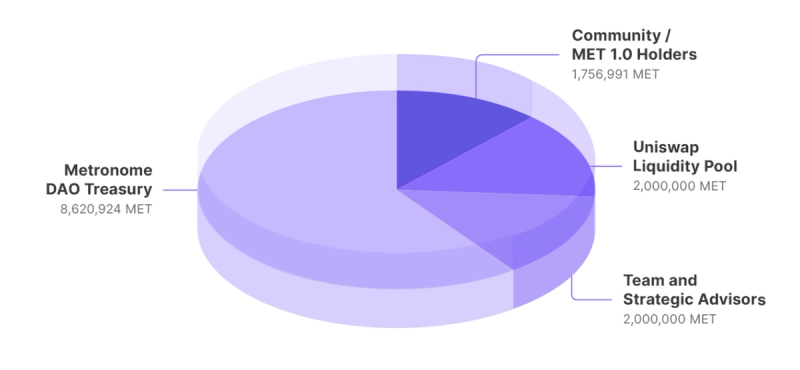
Source: MET 2.0 Initial Distribution
In 2018, Metronome (MET 1.0) emerged as one of the first autonomous currencies. As the DeFi landscape evolved over the subsequent four years, the limitations of MET 1.0’s contract framework became evident — particularly its inability to seamlessly integrate within the DeFi space. Recognizing this, the Metronome team rolled out Metronome 2.0 in August 2022 with a commitment to DeFi innovation. Metronome 2.0 notably included the formation of the Metronome DAO (MET DAO) and the concurrent migration to an enhanced version of the MET token to guide the DAO’s operations.
With this migration, the total circulating supply of MET 1.0 at the time, which stood at 14.3 million MET, became the capped total supply for the new MET token. Additionally, the MET DAO Treasury received an allocation of 8.2 million MET and 8,346 ETH from the now-deprecated Metronome 1.0 Autonomous Converter Contract. These funds, along with incoming operational revenues, support the continued development of the Metronome ecosystem, collaborations with other DeFi projects, and liquidity incentives. They also back the deployment of protocol-owned liquidity on leading DEXs. To date, LP contributions include 2 million MET, 1,000 ETH, and 250,000 USDC provided on Uniswap V3.
Through a token-weighted voting process on Snapshot, MET holders actively shape the protocol’s future. They make decisions on operational matters such as the integration of new collateral assets, directing MET token emissions, and managing treasury allocations. These decisions are then carried out by one of the three core Metronome teams: Engineering, Growth, or Operations.
A testament to this collaborative approach was the approval of Metronome Improvement Proposal 15 (MIP-015) on September 18, 2023. This decision set aside 3.5 million MET tokens (24% of the total supply) from the MET DAO treasury for liquidity incentives and strategic partnerships. It also introduced esMET (escrowed MET), enhancing the token’s functionality beyond governance and liquidity incentives.
esMET
esMET is built upon the vote-escrow (ve) model, popularized by Curve, where token lockups lead to a range of benefits via veCRV. However, esMET introduces pivotal changes to address the traditional model’s challenges related to lockup commitments, the gradual erosion of voting power, and transfer limitations. When users opt to lock MET, the protocol issues esMET in exchange. The amount of esMET received is correlated with the duration of the lockup: the longer the lockup, the greater the amount of esMET exchanged. Users can lock their MET for durations ranging from one week to two years, with the two-year lockup offering the highest exchange rate of 5 esMET for every MET.
While the enhanced functionality of MET has yet to go live, esMET holders stand to gain exclusive benefits in the Metronome ecosystem:
- Smart Farming Boosts: Ample liquidity is key for the smooth operation of Metronome synths and is a prerequisite for the Smart Farming feature. To incentivize this, the protocol rewards users who supply liquidity to eligible synth pairs. By also locking some MET for esMET, users can “boost” the capital efficiency of Smart Farming positions. Per MIP-015, the “boost” each user receives will be influenced by their contributed synth LP and their esMET holdings, among other global factors.
- Trading Fee Discounts: esMET unlocks tiered discounts on the standard 0.25% swap fee in the Synth Marketplace based on the level of a user’s holdings. The discount tiers are:
- 20% for 500 esMET
- 40% for 5,000 esMET
- 60% for 50,000 esMET
- 80% for 500,000 esMET
For perspective, a two-year lockup of 100,000 MET (equivalent to 500,000 esMET) would reduce the swap fee to just 0.05%.
- Access to Gated Pools: esMET is also set to provide entry to various gated pools where access is determined by a user’s esMET holdings. For instance, gated pools with higher collateral ratios would likely require a more substantial esMET holding compared to other pools. In practice, esMET holders could utilize such pools to achieve higher returns in the open market without the need for additional emissions from the MET DAO treasury.
One standout feature of esMET is its encapsulation of locked positions as ERC-721 tokens. This design choice offers flexibility by allowing users to simultaneously hold distinct positions and transfer them freely. Furthermore, esMET positions intentionally lack a time-based decay to ensure consistent benefits without the need for periodic re-locking. For users contemplating an early exit, esMET offers a solution in the form of a diminishing unlock fee. The fee starts at 50% and tapers to 0% over the lock-up period.
Synth Issuance

The minting process for Metronome synths is straightforward. Each supported collateral asset is subject to a deposit cap, ensuring a balanced backing for Metronome synths. These caps are integral to calculating synth mintage limits.
If a desired collateral asset’s deposit cap isn’t maxed out, users can deposit their tokens. Upon doing so, Metronome issues deposit tokens on a 1:1 basis. These tokens serve a dual purpose: 1) they act as a receipt, representing the user’s claim on the assets in the pool, and 2) they enable users to mint synthetic assets.
Similar to many lending platforms, Metronome’s deposit tokens come with an attached Collateral Factor (CF). This CF limits the synth value that can be borrowed against the deposit. To balance risk and offer competitive CFs, Metronome employs a risk assessment framework. This considers factors like market cap, liquidity, Lindy score, peg volatility, and rehypothecation.
After securing their collateral, users can head to the synthetics dashboard. There, they can create a synthetic asset, provided there’s mintage capacity. Each synth’s mintage cap is shaped by the deposit caps and CFs of collateral options of a similar “type”. For clarity, the current mintage cap for msUSD, Metronome’s synthetic USD, is determined as:
Max msUSD = (USDC deposit cap * CF) + (FRAX deposit cap * CF) + (DAI deposit cap * CF) + (vaUSDC deposit cap * CF) + (vaFRAX deposit cap * CF).
Utilizing Synths
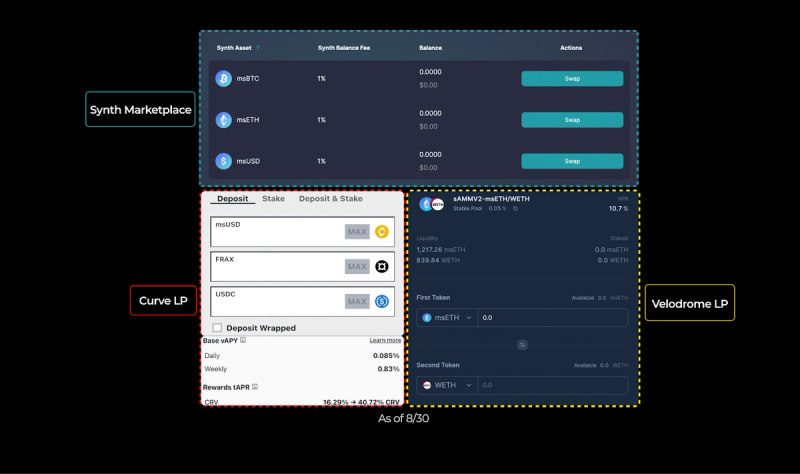
Source: Metronome, Curve, Velodrome
Metronome’s synths function as dynamic debt instruments within the DeFi ecosystem. Outside of their role in Smart Farming, synths can be utilized for zero-slippage trading in the Synth Marketplace. They can also be tapped for arbitrage opportunities or paired with real-world counterparts through various liquidity provision strategies. A prevalent LP strategy among users is to leverage the low fixed-interest rate of synths to earn risk-adjusted returns on blue-chip assets from swap fees and token incentives on DEXs such as Velodrome and Curve. This approach gradually reduces the cost basis while also enabling users to tap into governance and incentive opportunities across various platforms.
However, there is a key distinction. Within the Metronome platform, synths adhere to a hardcoded 1:1 value with targeted assets such as ETH or USD. Yet, in the open market, they operate on a soft peg. As such, their exchange value is influenced by market dynamics and can differ across individual liquidity pools.
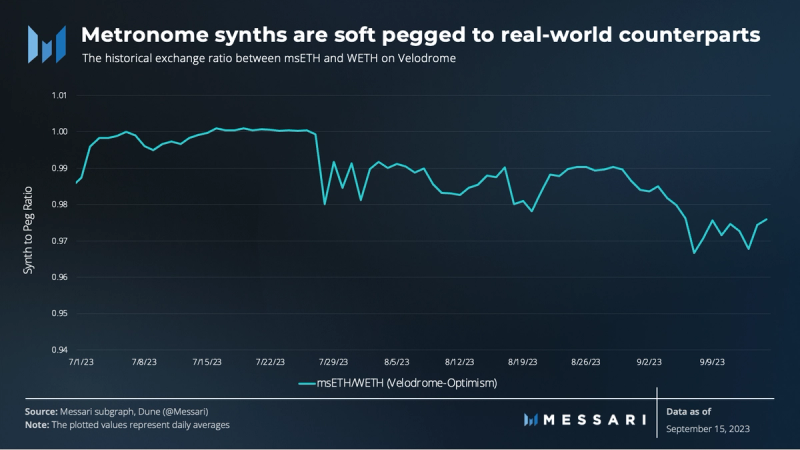
The inherent soft-peg nature of synths in the open market presents arbitrage opportunities. When the peg is strong, users are incentivized to exit positions and capitalize on favorable exchange rates. Conversely, when the peg weakens, purchasing synths becomes the more attractive option. This dynamic, combined with mintage caps and enticing liquidity incentives, aids in stabilizing the synth pegs.
On the other hand, blindly employing this strategy might erode gains or even lead to losses. It is essential to be aware and timely when navigating these market nuances. Moreover, these synthetic assets are intentionally overcollateralized to ensure a consistent relationship between the issued amount and the underlying collateral. Even so, the system remains susceptible to market fluctuations. If the value of a synth position exceeds the collateralization threshold set by each market’s CF, the collateral becomes vulnerable to liquidation. Such an event can be triggered by a drop in the collateral’s value or by a position failing to generate adequate returns over time, given the effects of compounding interest.
Smart Farming
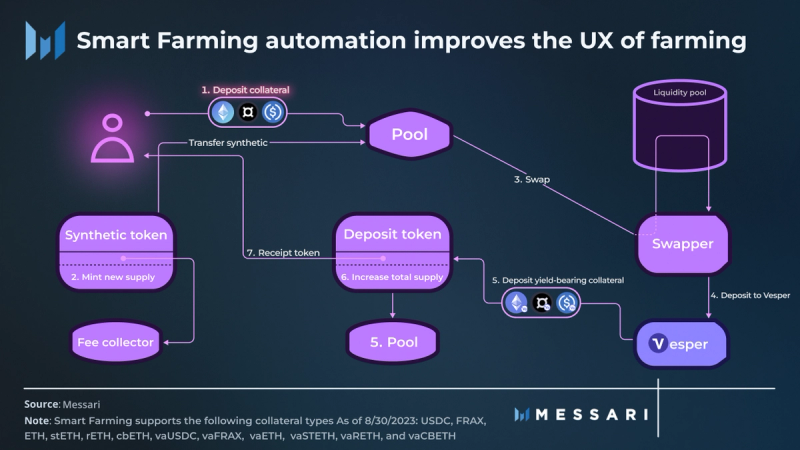
Metronome’s Smart Farming tool leverages its internal synth issuance mechanism to offer superior capital efficiency in the leverage yield farming domain. Initiating a Smart Farming position is a streamlined process, facilitated by a “Flash Mint” mechanism. Here’s a breakdown:
- Initial Deposit and Configuration: Users start by depositing their collateral, which can include assets like ETH, USDC, FRAX, or yield-bearing positions tied to these assets. During this phase, users specify a “Loop” or collateral multiple and set the maximum price impact permissible for the subsequent swap.
- Flash Minting of Synths: Once the collateral is secured, the protocol initiates a flash mint, creating a synthetic asset that’s based on the loop of the deposited collateral. This flash minting bypasses the need for an initial check on the user’s collateral value for over-collateralization. As a result, it is central to the cost-efficiency of Smart Farming.
- Asset Swapping: The original collateral and the newly minted synthetic asset are swiftly routed to a DEX, such as Curve. There, they’re swapped for their real-world equivalents as necessary.
- Yield Optimization: The real asset is then wrapped into a productive position using platforms like Vesper, a DeFi middleware yield aggregator
- Final Deposit: The yield-enhanced asset is then channeled back to the Metronome protocol. Users receive both a deposit and a debt position, covering the full collateral and the synthetics.
Because this Smart Farming approach is executed through a single user interaction, it results in up to 90% savings on transaction costs. In addition, it relieves users from the intricacies of managing multiple steps or preliminary assets.
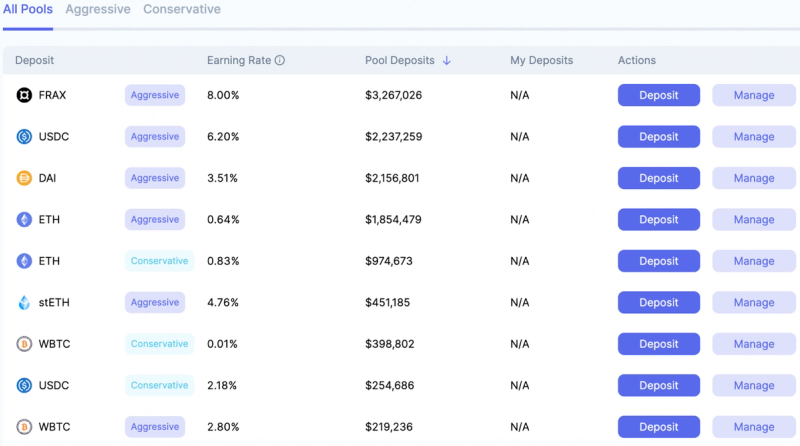
Source: Vesper
Smart Farming requires users to make an initial choice of collateral. While the system can accommodate various yield-bearing collaterals, it initially supports only Vesper’s vaTokens. Vesper offers a diverse range of interest-yielding pools. When users opt for single-asset pools, they are awarded vaTokens, representing their stake in the pooled assets. These deposits are then strategically channeled across renowned DeFi platforms, including MakerDAO, Aave, Compound, and Yearn.
Then, the yield generated from these platforms is credited to vaTokens, leading to a progressive increase in the exchange rate between vaTokens and the base assets. Throughout this system, Smart Farming users gain consolidated exposure to multiple yield sources.
Navigating Smart Farming
The capacity to provide Smart Farming leverage is intrinsically tied to the market liquidity available for swapping an issued synth with its real-world counterparts. With sufficient liquidity, users can engage in Smart Farming and harness the peg dynamics. By entering a Smart Farming position during a strong peg and exiting during a weak one, users can benefit from the increased volume of assets both wrapped into and retrieved from yield-bearing positions. This strategy noticeably boosts capital efficiency, achieved independently of the benefits from leverage. However, reversing this approach or misunderstanding the dynamics can amplify potential losses.
Beyond the inherent risks associated with smart contracts, the primary concern in Smart Farming is the potential for collateral assets to lose their peg. A depeg could occur if the Vesper wrapper encounters issues, or if the base asset, such as a stablecoin or liquid staking token, deviates from its peg. While vaTokens are designed to consistently appreciate relative to their base assets, unexpected shifts can jeopardize Smart Farming positions, making vaTokens prone to liquidation.
Due to the leveraged nature of Smart Farming, liquidations can result in substantial losses. In such scenarios, users not only risk losing their collateral but also miss out on the opportunity to counterbalance losses by selling the borrowed assets. Importantly, the strategy of Smart Farming offers a layer of protection against such risks, as it borrows native assets against their yield-bearing versions. For real-time insights and position management, users can directly access the Metronome dashboard.
Closing Summary
Metronome’s evolution into its 2.0 version epitomizes its spirit of innovation and adaptability. With a multi-collateral and multi-synthetic foundation tailored for both newcomers and seasoned DeFi veterans, Metronome’s toolkit enables users to amplify their onchain yields by minting synthetic assets backed by productive collateral — all while enhancing their exposure to specific assets or pools.
Apart from offering synthetic leverage, Metronome’s suite of services includes the Synth Marketplace and a Smart Farming tool, which refines and automates leverage yield farming strategies. Synths have a fixed rate annual borrowing cost of 1%, and their peg’s value is maintained through dynamic mintage parameters, arbitrage opportunities, and liquidity incentives. While the MET token primarily steers protocol governance and incentivizes synth liquidity, the recently approved multi-faceted esMET functionality offers MET lockers exclusive benefits within the Metronome ecosystem. Through this holistic approach, Metronome provides users with a streamlined and intuitive entry into the DeFi universe, positioning itself as a leader in the evolution of modern DeFi tooling.
















